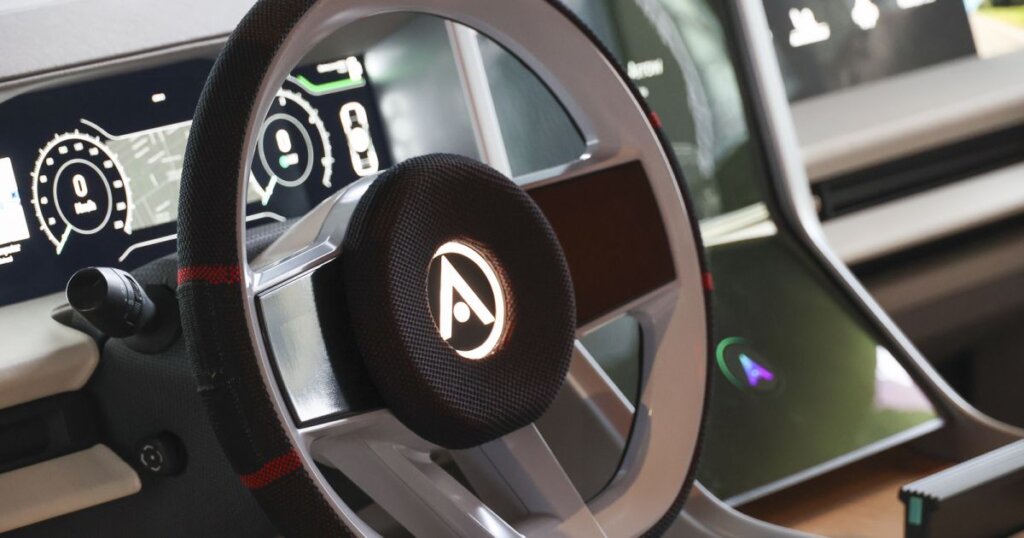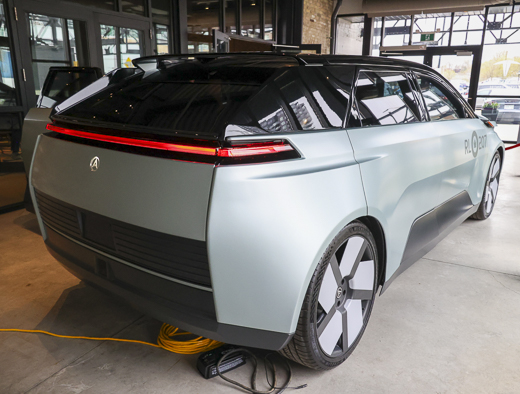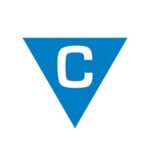Home » A ‘moonshot’ for Canadian EV tech
A ‘moonshot’ for Canadian EV tech

The future of automotive transportation rolled into the Communitech Hub this week with all the grace and style of an electric thoroughbred.
The sleek-looking prototype – a zero-emission SUV cross – is the product of Project Arrow, a collaborative effort to showcase the talents of Canadian researchers, engineers and auto-parts makers as the world turns to electric vehicles to help mitigate climate change.
“This is a Canadian moonshot,” said Flavio Volpe, president of the Automotive Parts Manufacturers’ Association (APMA), which initiated Project Arrow. “This is a fully functioning, made-in-Canada prototype that could go into production.”
Some of the prototype’s coolest features:
- 3D-printed chassis, made of polymer and metal.
- Solar-panel roof to augment the vehicle’s 82.5-kilowatt-hour lithium-ion battery.
- Dual electric motors that generate 550 horsepower.
- Estimated range of 500 kilometres.
- Sensors in the driver’s seat and steering wheel that can detect if the driver is having a medical emergency, and then direct the vehicle to drive itself to the nearest hospital.
- Digital security to protect data, privacy and prevent vehicle hacking.
- Interior finish featuring Canadian maple hardwood floor and trim.

The Project Arrow concept car at the Tannery Event Centre.
(Communitech photo: Anthony Reinhart)
The Arrow’s stop at the Hub in downtown Kitchener is part of a North American tour, which began in January when it debuted at the Consumer Electronic Show in Las Vegas.
Communitech was chosen because of its role in accelerating the regional development and commercialization of next-generation electric, connected and autonomous-vehicle technologies. It’s doing so in partnership with the University of Waterloo and the Ontario Vehicle Innovation Network (OVIN), both of which have contributed to Project Arrow.
“Our work with OVIN and UW aims to support and leverage the world-class expertise and talent that exists here in Waterloo Region,” said Communitech CTO Kevin Tuer. “Ontario was once dominant in auto manufacturing. As the world strives to transform the industry and develop safer and cleaner vehicles, initiatives like OVIN and Project Arrow show that we can re-own the podium through advanced manufacturing and the application of leading-edge technologies.”
The APMA launched Project Arrow in 2020, saying it was “answering” the federal government’s call for more zero-emission vehicles by bringing “together the best of the best of Canada’s electric-drive, alternative-fuel, connected and autonomous, light-weight technology in the road-going Arrow.”
As climate change fuels the need to reduce carbon emissions, many countries and automakers have begun moving away from gas-burning vehicles and transitioning to electric-vehicle production.
U.S. President Joe Biden has unveiled a broad plan to encourage “America’s historic transition” away from fossil-fuel-powered vehicles. His goal is to boost EV sales to 50 per cent of all U.S. vehicle sales by 2050.
Canadian targets are even more ambitious: 20 per cent of new passenger vehicles sold in Canada to be emission-free by 2026, rising to 60 per cent by 2030 and 100 per cent by 2035.
The name “Project Arrow” is a nod to the Avro CF-105 Arrow, a Canadian fighter jet developed in the 1950s. At the time, the all-Canadian Arrow prototype was the most advanced aircraft of its kind. It became a symbol of the country’s innovation, aspirations and potential. Just a year after the Arrow’s inaugural flight, however, the federal government abruptly scrapped the program amidst a controversial cost-cutting campaign.
The proponents of today’s Project Arrow want to highlight the dramatic transformation that technology is having on automobile design and manufacturing, while also showcasing Canada’s potential to play a lead role in the reborn industry.
Project Arrow kicked off with a design competition in mid-2020. A proposal submitted by four students from Carleton University’s School of Industrial Design won out over 24 competitors.
With the Carleton design in hand, the Project Arrow vehicle was built at Ontario Tech University in Oshawa, which has research and teaching expertise in auto manufacturing as well as strong ties to the industry.
A call for Canadian-made technology and parts attracted more than 500 submissions. In the end, nearly 60 suppliers were chosen – including several from Waterloo Region.
The University of Waterloo’s Mechatronic Vehicle Systems (MVS) Lab designed and partially built the vehicle’s powertrain, with assistance from MVS spinoff company Audesse.
Other area companies that supported or contributed to Project Arrow include Geotab, which has an office in Kitchener and makes digital security and GPS vehicle-tracking systems, and Toyota Motor Manufacturing Canada, which has manufacturing facilities in Cambridge and nearby Ingersoll.
The Arrow Project, which cost $20 million, received funding from Ottawa and the governments of Ontario and Quebec, as well as in-kind components from Canadian auto and tech companies.

Communitech CEO Chris Albinson (left) and Linamar executive Mark Stoddart in
conversation at the Project Arrow event. (Communitech photo: Anthony Reinhart)
At today’s showcase event, Communitech CEO Chris Albinson held a fireside chat with Mark Stoddart, Chief Technology Officer and Executive Vice-President of Sales and Marketing at Guelph-based auto-parts maker Linamar, which was an adviser to Project Arrow.
The shift from gas- and diesel-powered automobiles to electric vehicles packed with advanced technology has ignited a far-reaching revolution in the industry.
“This is the biggest change we’ve seen since Henry Ford,” Stoddart said.
Linamar is a prime example.
The company was started in 1964 by Hungarian immigrant Frank Hasenfratz, who set up a one-man machine shop in his basement. Today, Linamar is a publicly traded company (TSX:LNR) with nearly $8 billion in sales, more than 60 facilities around the globe and expertise in several industries, primarily auto parts.
The company established the Linamar Innovation Hub (iHub) for R&D and to partner with outside startups to develop new products across the range of industries that Linamar serves.
“We’re constantly improving processes… we want to innovate more and more,” Stoddart said.
Meanwhile, the APMA’s Flavio Volpe said his interest in automobiles goes back to a childhood memory of sitting in an Italian-made Ferrari sportscar at the Canadian International AutoShow in Toronto.
By bringing the Project Arrow vehicle to such shows, he hopes to inspire Canadians to play a lead role in a transformed auto industry.
“In 10 years, some of those kids and some of those adults who go to these shows will be able to buy Canadian cars under a Canadian brand,” Volpe said. “And it’s going to be that moment that they said, ‘Oh, wow, we can do the whole thing here.’ ”
Communitech
https://communitech.ca
"Communitech helps tech-driven companies start, grow and succeed. Communitech was founded in 1997 by a group of entrepreneurs committed to making Waterloo Region a global innovation leader. At the time it was crazy talk, but somehow this community managed to pull it off. Today, Communitech is a public-private innovation hub that supports a community of more than 1400 companies — from startups to scale-ups to large global players. Communitech helps tech companies start, grow and succeed in three distinct ways: - Communitech is a place – the center of gravity for entrepreneurs and innovators. A clubhouse for building cool shit and great companies. - Communitech delivers programs – helping companies at all stages with access to capital, customers and talent. We are here to help them grow and innovate. - Communitech partners in building a world-leading ecosystem – making sure we have all the ingredients (and the brand) to go from a small startup to a global giant."


